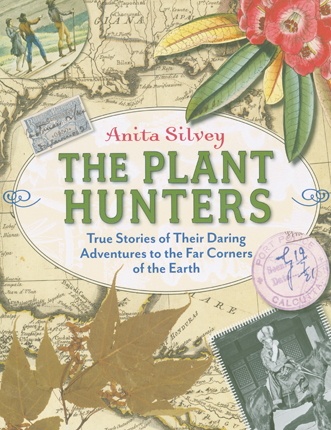| Plant hunters : true stories of their daring adventures to the far corners of the Earth Author: Silvey, Anita | ||
| Price: $23.98 | ||
Summary:
Introduces us to the nineteenth-century plant hunters whose discoveries became the basis for the development of botany.
| Accelerated Reader Information: Interest Level: MG Reading Level: 8.30 Points: 2.0 Quiz: 150650 | Reading Counts Information: Interest Level: 6-8 Reading Level: 9.80 Points: 6.0 Quiz: 57137 | |
Common Core Standards
Grade 3 → Reading → RI Informational Text → 3.RI Key Ideas & Details
Grade 3 → Reading → RI Informational Text → 3.RI Craft & Structure
Grade 3 → Reading → RI Informational Text → 3.RI Integration of Knowledge & Ideas
Grade 3 → Reading → RI Informational Text → Texts Illustrating Complexity, Quality, & Range of
Grade 4 → Reading → RI Informational Text → 4.RI Key Ideas & Details
Grade 4 → Reading → RI Informational Text → 4.RI Craft & Structure
Grade 4 → Reading → RI Informational Text → 4.RI Integration of Knowledge & Ideas
Grade 4 → Reading → RI Informational Text → Texts Illustrating the Complexity, Quality, & Rang
Grade 4 → Reading → CCR College & Career Readiness Anchor Standards fo
Grade 6 → Reading → RI Informational Text → 6.RI Range of Reading & Level of Text Complexity
Grade 6 → Reading → CCR College & Career Readiness Anchor Standards fo
Reviews:
Kirkus Reviews (03/01/12)
School Library Journal (06/01/12)
Booklist (04/15/12)
The Bulletin of the Center for Children's Books (A) (05/12)
Full Text Reviews:
Booklist - 04/15/2012 Combining bits of botanical history and exploration with accounts of adventurers, this unusual book introduces European and North American plant hunters, primarily from the nineteenth and twentieth centuries. Driven by curiosity, commerce, and “botonomania,” they sought to collect valuable plant specimens around the world. Likening Baron Alexander von Humboldt to Indiana Jones and calling the plant hunters’ experiences “amazing escapades,” Silvey raises readers’ expectations for adventure tales and satisfies them by recounting horrific experiences reported by various plant hunters. The danger is that their identities, personalities, and achievements become less memorable than the ordeals they endured. Some of the best parts of the book are the less sensational but more significant, such as the clandestine export (or, more plainly, theft) of rubber trees from Brazil and tea plants from China. Reproduced in color, archival photos, prints, and documents appear throughout the book. Source notes identify the many quotes used in the text. An accessible account of plant hunters, a topic less widely explored than, say, dinosaur hunters. - Copyright 2012 Booklist.
Bulletin for the Center... - 05/01/2012 Forget your tree-hugging vegans, gardening grannies, and bespectacled botanists. Silvey’s plant enthusiasts, featured herein, are more likely to be restless adventurers, savvy investors, or even wily scoundrels. The focus is on Western naturalists who scoured remote regions for plants yet unknown to mainstream collectors in what they regarded as the “civilized” world. With botanical garden and private collectors clamoring—and paying—for floral novelties, the eighteenth and nineteenth centuries were prime time for men (and a few women) curious and brave enough to risk their lives in pursuit of an uncatalogued plant. The perspective tends to be that of the adventurers themselves, and the tales of facing wild elements, punishing terrain, and life-threatening insects and beasts carry the clubby scent of leather chairs, cigars, and a good coal fire. Although Silvey describes the illegal British acquisition of tea and cinchona plants and seeds from China and South America, there is little actual discussion of colonialism; nor does she address any unintended consequences of transplanting biota into non-native regions. While the limited scope of this title is better designed to whet than satisfy the appetite of a budding botanist, it does successfully infuse the image of plant collection with a measure of excitement many readers will not expect. Black and white photographs, a timeline, chapter notes, a bibliography, and an index are included. EB - Copyright 2012 The Board of Trustees of the University of Illinois.
School Library Journal - 06/01/2012 Gr 5–8—Getting plants at the local garden center for one's home garden seems simple enough. But the incredible array of choices available—daffodils, tulips, hyacinths, geraniums, and begonias to name a few—is the result of centuries of global plant exploration and gathering. Organized by topic, Silvey's narrative flows from the motivation of these plant hunters, the difficulties they faced in transporting their finds across great distances, and the extreme threats to their lives (some didn't survive). The accounts of stealing such valuable plants as Brazilian rubber trees and Chinese teas for economic gain and the Ecuadorian cinchona plant for its antimalarial qualities read more like spy adventures than benign plant collectors' stories. The three-page bibliography will direct curious readers to books and websites for further information. For readers interested in specific plants, topics and/or individuals, the multipage index will lead the way to such specifics as Humboldt's description of banana trees, the discovery of a new gentian in Arkansas in 2001, and various expeditions to the Himalayas. Beautifully illustrated with color reproductions of old botanic drawings and photographs, this is a lovely presentation of amazing adventures.—Frances E. Millhouser, formerly at Chantilly Regional Library, Fairfax County, VA - Copyright 2012 Publishers Weekly, Library Journal and/or School Library Journal used with permission.



